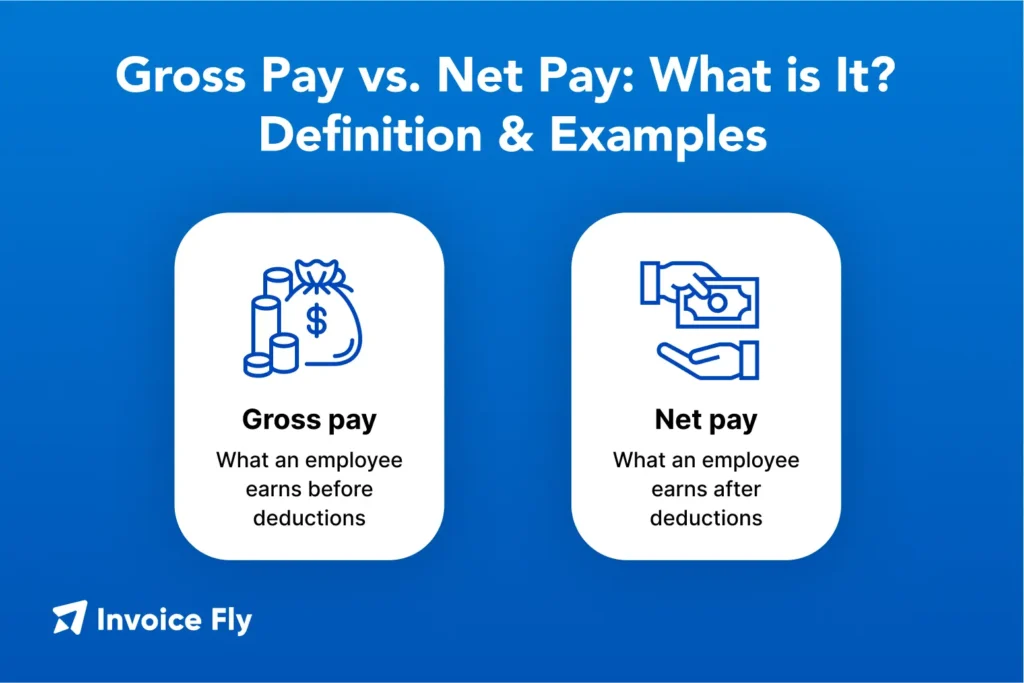Gross Pay vs. Net Pay: What is It? Definition & Examples

Table of Contents
Understanding your paycheck can feel confusing, especially when you see different terms like gross pay and net pay. While gross pay represents the total amount you earn before deductions, net pay is the actual amount you take home after taxes and withholdings. Knowing how to calculate and interpret net pay is essential whether you’re an employee budgeting monthly expenses or an employer managing payroll.
In this guide, we’ll break down what is net pay, how it differs from gross pay, and why it matters. You’ll learn how to calculate net pay each pay period, what factors reduce it, and see real-life examples that make the concept simple to grasp. By the end, you’ll have a clear understanding of your paycheck and how net pay impacts both financial planning and payroll management.

Need a payment processing solution for your small business? Try Invoice Fly’s Invoicing Software — it’s free!
What is Net Pay? (Definition)
Net pay is the money you actually get to keep from your paycheck. It’s what’s left after your employer takes out taxes and other deductions.
Think of it this way: If someone offers you a job paying $50,000 a year, that’s your gross pay. But you won’t see all $50,000. After taxes and deductions, you might only get $35,000 to $40,000. That smaller amount is your net pay — your real take-home money.
Your pay stub shows both numbers. Gross pay is at the top. Net pay is at the bottom. The net pay meaning in payslip is simple: it’s the final amount you can actually spend.
What Affects Net Pay?
Lots of things reduce the money between what you earn and what you keep. Here are the main ones:
- Federal income tax: The government takes a percentage based on how much you earn
- State income tax: Most states take their own cut too (though some states have no income tax)
- FICA taxes: According to the IRS, this pays for Social Security (6.2%) and Medicare (1.45%). Together that’s 7.65% of your paycheck.
- Extra Medicare tax: If you earn over $200,000 a year, you pay an extra 0.9%
- City or county taxes: Some places add local taxes on top
- Health insurance: Your share of medical, dental, and vision coverage
- Retirement savings: Money you put into a 401(k) or similar plan
- Other benefits: Things like HSA, FSA, life insurance, or disability insurance
- Wage garnishments: Court-ordered payments for debts or child support
- W-4 form: How you fill out this employee withholding certificate determines how much tax is taken from each paycheck.
How to Calculate Net Pay? (Step-by-Step, Include Formula)
Here’s the basic formula:
Net Pay = Gross Pay – Taxes and Deductions
Follow these steps to figure it out:
- Start with gross pay: Your total earnings before anything comes out
- Remove pre-tax deductions: Things like retirement and health insurance
- Find taxable income: What’s left after step 2
- Take out taxes: Federal, state, local, and FICA (usually 7.65%)
- Remove after-tax deductions: Things like garnishments or Roth 401(k)
- You’re done: What’s left is your net pay
According to ADP, doing this correctly builds trust between employers and workers.
How to Calculate Net Pay Each Pay Period
How often you get paid matters. Here are the common schedules:
- Weekly: 52 paychecks per year
- Bi-weekly: 26 paychecks per year (every two weeks)
- Semi-monthly: 24 paychecks per year (twice a month)
- Monthly: 12 paychecks per year
If you’re salaried, divide your yearly salary by number of paychecks. If you’re hourly, multiply your rate by hours worked, then take out deductions. Want to estimate your yearly net pay? Check out how many hours people work in a year.
What Can Reduce Net Pay?
Some things can make your paycheck smaller than usual:
- You changed your W-4 and now more tax gets withheld
- You started new benefits or your premiums went up
- Court orders say money must be taken from your check
- You increased your retirement contributions
- You lost tax credits (like when kids turn 18)
- You started earning over $200,000 (triggers extra Medicare tax)
- You put more money into HSA or FSA accounts

What is Gross Pay?
Now let’s talk about the other side of the coin. Gross pay is everything you earn before any money gets taken out. It’s the big number your employer talks about when they hire you.
When a job posting says “$25 per hour” or “$60,000 per year,” that’s gross pay. It includes:
Your regular salary or hourly wages
- Overtime pay (usually 1.5 times your normal rate)
- Bonuses and commissions
- Tips
- Holiday pay and sick pay
- Severance payments
- Stock options (when you use them)
Calculating Gross Pay? (Step-by-Step, Include Formula)
The math depends on how you get paid:
If you’re salaried:
Gross Pay = Yearly Salary ÷ Number of Paychecks
Example: You earn $60,000 per year and get paid monthly. $60,000 ÷ 12 months = $5,000 per paycheck
If you’re hourly:
Gross Pay = (Regular Hours × Pay Rate) + (Overtime Hours × Overtime Rate)
Example: You earn $15 per hour and work 45 hours this week. Regular: $15 × 40 hours = $600 Overtime: $15 × 1.5 = $22.50 per hour × 5 hours = $112.50 Total gross pay: $712.50 for the week
Remember, overtime means 1.5 times your normal pay for hours over 40 per week.
Calculating Gross Income?
Gross income is your total earnings for a whole year before any deductions:
Gross Income = Gross Pay per Paycheck × Paychecks per Year
Example: You get $2,500 every two weeks. $2,500 × 26 paychecks = $65,000 per year
Want to learn more? Read our guide on how to calculate gross income from W2.
Invoice Fly is a smart, fast, and easy-to-use invoicing software designed for freelancers, contractors, and small business owners. Create and send invoices, track payments, and manage your business — all in one place.Get Started with Invoice Fly’s Software

Net Pay vs. Gross Pay: What is the Difference?
Here’s the simple truth:
Gross pay = what you earn. Net pay = what you keep.
Let’s break down how they’re different:
Gross Pay:
- Total money before anything gets taken out
- What job offers advertise
- Shows up at the top of your pay stub
- The bigger, better-sounding number
- Still has to pay taxes and benefits
Net Pay:
- Real money that goes in your bank
- What you can actually spend
- Shows up at the bottom of your pay stub
- The smaller but more important number
- Already has everything taken out
According to BambooHR, the gap between net pay vs gross pay is usually 25-30% or more. So if you earn $60,000 gross, you might only take home $42,000-$45,000 net.

Why Net Pay Is Important?
Knowing your net pay matters whether you’re an employer or employee.
Net Pay for Employers
Getting net pay right helps your business in several ways:
- Builds trust: Workers trust you when paychecks are accurate
- Keeps you legal: Proper taxes and withholding keeps the IRS happy
- Helps you budget: Know the real cost of each employee
- Protects you: Good records help if you get audited
- Keeps workers happy: Clear pay stubs mean fewer questions and complaints
Net Pay for Employees
Understanding your net pay helps you manage money better:
- Budget correctly: Know exactly how much money you’ll have each month
- Plan ahead: Set realistic savings goals based on real income
- See your full value: Understand benefits beyond just salary
- Get loans easier: Lenders look at your actual take-home pay
- Fix tax problems: See if you need to change your W-4 withholding
Getting a raise? Check our guide on how to work out salary increase percentage to see how it affects your net pay.
Want to stay organized? Use Invoice Fly’s Invoice Maker to track income and expenses — free!
1. Salaried Employee Net Pay
Sarah works in marketing. She earns $72,000 per year, gets paid monthly, is married with two kids, and lives in a state with 5% income tax.
Here’s how her paycheck breaks down:
- Gross pay each month: $6,000 ($72,000 ÷ 12)
- 401(k) savings (5%): -$300
- Health insurance: -$250
- What gets taxed: $5,450
- Federal tax (12%): -$654
- FICA taxes (7.65%): -$417
- State tax (5%): -$273
- Net pay: $4,106 per month
- Take-home for the year: About $49,272
Sarah keeps 68% of her gross pay. The other 32% goes to taxes and benefits.
2. Hourly Worker Net Pay
Marcus works construction. He makes $22 per hour, works 40 hours a week, gets paid every two weeks, and lives in Texas (no state income tax).
Here’s his paycheck:
- Gross pay (80 hours): $1,760 ($22 × 80)
- 401(k) savings: -$100
- Health insurance: -$150
- What gets taxed: $1,510
- Federal tax (12%): -$181
- FICA taxes (7.65%): -$116
- State tax (Texas): $0 (Texas has no income tax!)
- Net pay: $1,213 per paycheck
- Take-home for the year: About $31,538
Marcus keeps 69% of his gross pay. Living in Texas helps because there’s no state tax.
3. Contractor Net Pay
James is a freelance plumber. He just got paid $5,000 for a project. She’s self-employed and single.
Her tax situation:
- Gross payment: $5,000
- Self-employment tax (15.3%): -$765 (she pays both halves of FICA)
- Federal income tax (22%): -$700
- State income tax (5%): -$200
- Net after taxes: About $3,335
Important: James should save about 33% of every payment for taxes. Contractors can lower taxes using tax deductions for contractors and home office deduction rules.

Final Thoughts
Understanding what is net pay versus gross earnings helps you manage money better. Whether you’re an employee trying to budget or an employer running payroll, knowing how to calculate net pay helps you make smart choices.
Remember this: gross pay is what you earn, but net pay is what you keep. Always budget based on net pay. Most people lose 25-35% between gross and net pay, so planning with the gross number will mess up your budget.
Yes, it’s frustrating to see a big chunk disappear from your paycheck. But those deductions pay for important things like Social Security, Medicare, healthcare, and retirement savings. They protect you now and help you later in life. Ready to manage your business finances better? Invoice Fly’s Invoicing Software helps you create professional invoices, track payments, and manage finances — all for free.
Get Started with Invoice Fly’s Software
Invoice Fly is a smart, fast, and easy-to-use invoicing software designed for freelancers, contractors, and small business owners. Create and send invoices, track payments, and manage your business — all in one place.

FAQs about Net Pay
Net pay is what you get after taxes and deductions come out of your gross pay. It's your actual take-home money — what you can spend. According to Sage, it's your real income after everything gets taken out.
$5,000 net means you receive $5,000 after all deductions. Your gross pay was higher — probably $6,500-$7,000 — before taxes and withholdings.
Net pay is after taxes are taken out. Gross pay is before taxes. Always budget using net pay because that's the real money in your account.
Use net pay for budgeting because it shows actual money you can spend. If you budget with gross pay, you'll overspend because that money never reaches your account.
Net pay can be shown yearly, monthly, bi-weekly, or weekly. It depends on what you're calculating. Yearly net pay is your total for 12 months. Monthly is the average per month.
Net pay doesn't directly change your credit score. But it affects your ability to pay bills on time, which does affect your score. Banks also look at net pay when deciding on loans. Learn more in our guide about what is a pay stub.
